overall vitality
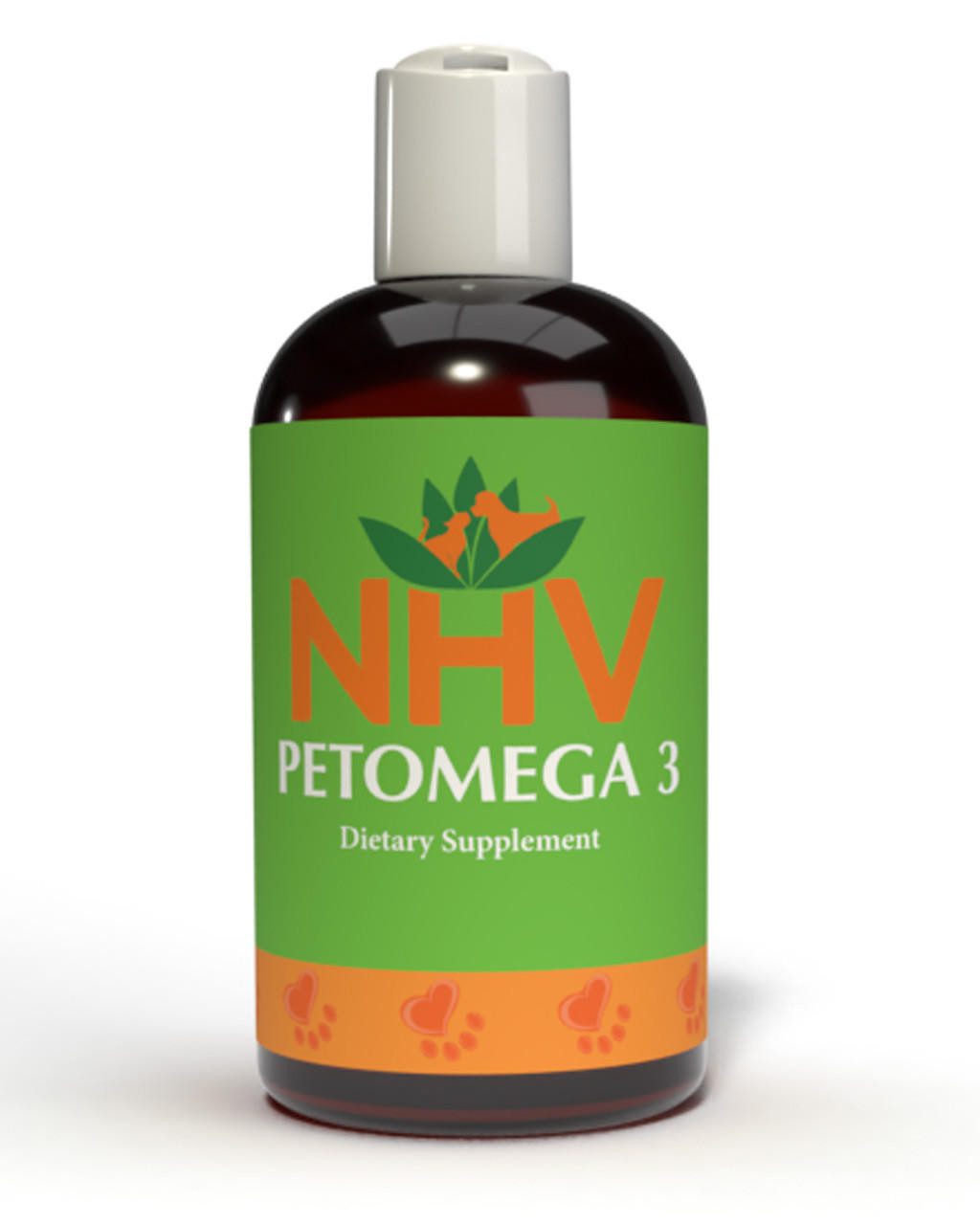
free shipping over $100 (USA & Canada)
1-877-937-4372 the pet expert hotline
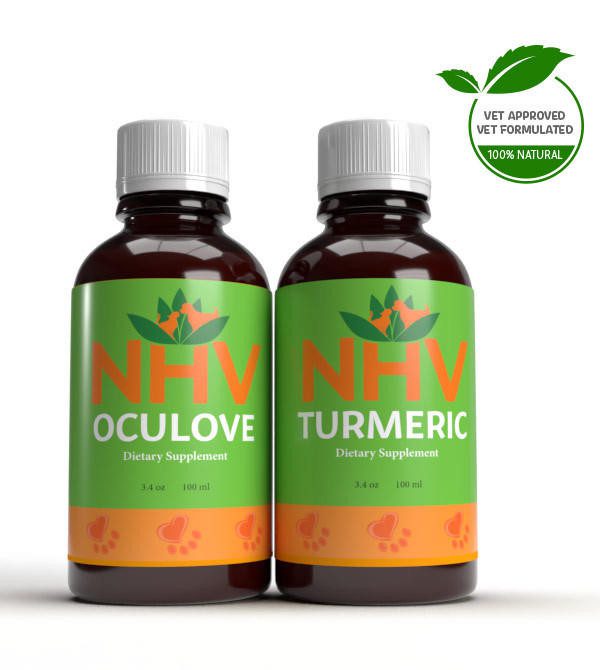
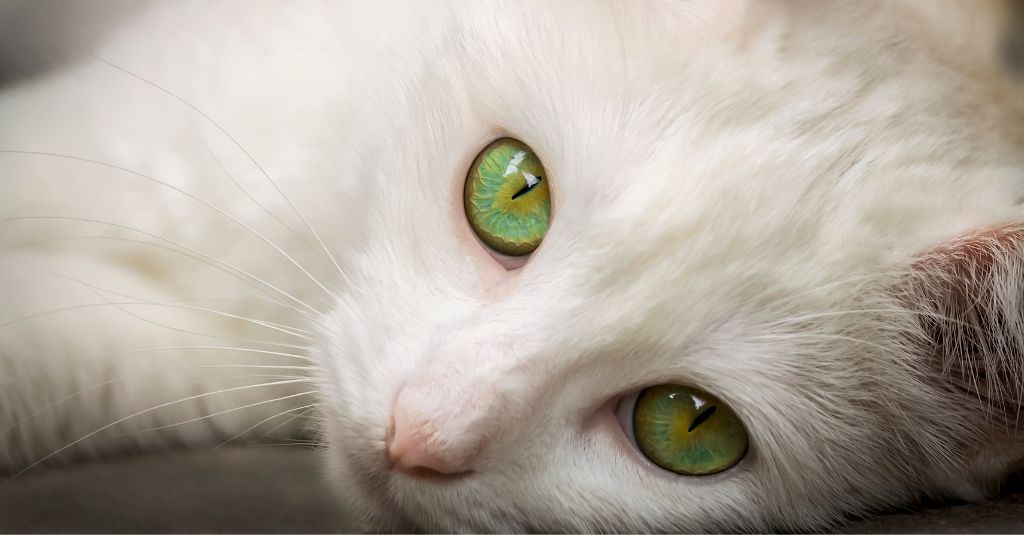
Have you ever noticed how cat pupils can change so much during the day? Looking into your kitty’s mesmerizing eyes can tell you a lot about their emotional state and health. Even though pupil size and shape can fluctuate based on light, a visual change in your little one’s eye can also point out to ocular diseases like cataracts or glaucoma.
Our cat’s wild ancestors relied heavily on their exceptional vision to hunt. Even though most kitties nowadays have readily available food in a loving home, they still have their hunter instincts and eyesight.
Looking into your kitty’s mesmerizing eyes can tell you a lot about their emotional state and health.
Unlike their canine friends, cats possess a wider field of view, enabling them to stalk prey with precision and accuracy. Their incredible visual acuity continues through the night when they can detect small movements even in low-light conditions.
Larger cat pupils and a higher number of rod cells in their retinas are the main reasons why cats have superior night vision capability to many other animals, including us humans. Our feline kiddos also have a well-developed tapetum lucidum, a reflective layer behind the retina that enhances their night vision.
So far, it sounds like cats have their eyes on us and are ready to rule the world, right? But unfortunately, there are a few negatives when it comes to our kitty’s eyesight.
Cats have a more limited color perception than dogs, for example. Their vision lean towards the blue and green end of the spectrum. And most importantly, the cat’s unique eye structure and several breed predispositions contribute to their susceptibility to many issues, including:
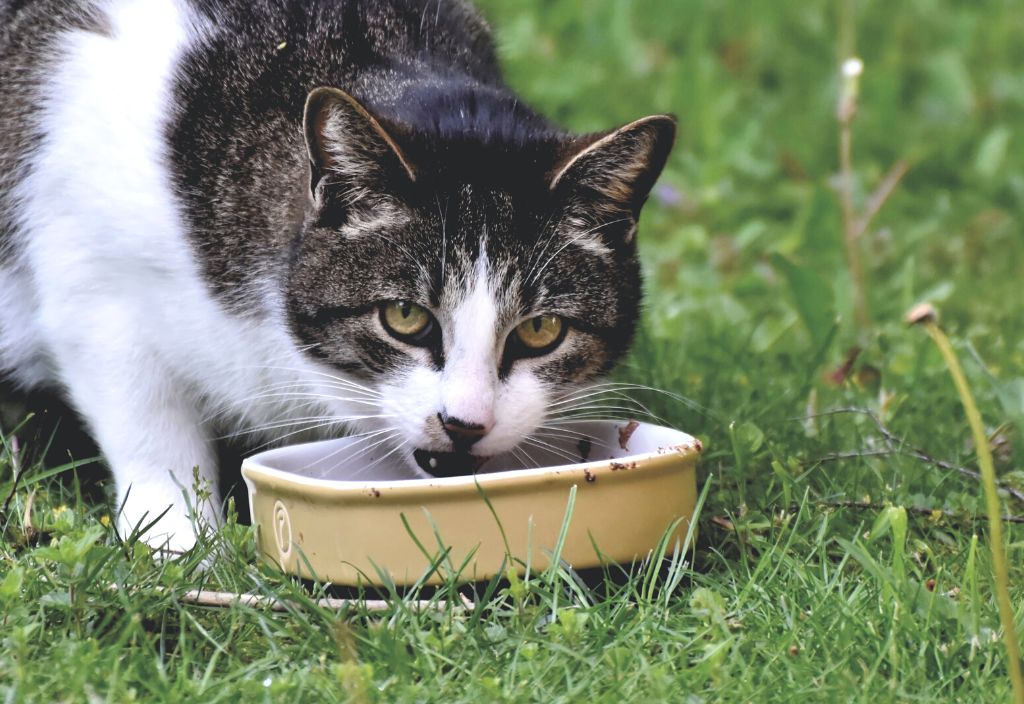
A correct diet and proper water intake help promote eye lubrication, prevent dry eyes, and improve overall eye health. Natural supplements can also make a difference in managing your cat’s eye health. Here are a few things to have in mind when planning a regimen for proactive eye support:
Vitamin A, present in ingredients like sweet potato and carrots, plays a vital role in your little one’s vision. Vitamin C and Bioflavonoids help strengthen blood vessels in the eyes and reduce the risk of conditions like cataracts. Despite a balanced diet, the use of nutritional supplements like NHV Multi Essentials and NHV OcuLove can help ensure your little one has the correct intake of these vitamins for healthy eye function.
Antioxidants, such as lutein and zeaxanthin, help protect the eyes from damage caused by free radicals. For added support, NHV Turmeric offers antioxidant properties that can help slow down vision loss and progressive eye disease.
Found in fish oil or flaxseed oil, omega-3 fatty acids have anti-inflammatory properties that support eye health. If you are looking for an easy alternative, NHV PetOmega 3 is a vet-formulated fish oil blend designed specifically for animals. And most kitties love the taste!
Kitties require sufficient levels of taurine, an essential amino acid that they need to get from the meat in their diet. Low levels of taurine in a cat’s body can lead to eye issues, digestive problems, and a weakened heart and can cause delayed growth in young kittens.
If you notice any changes in your cat pupils or suspect an eye problem, consult with a veterinarian for a proper diagnosis and appropriate treatment. In the meantime, please know that we are here to help you in any way! Click the button below and start talking to someone in our team of pet experts for support.
overall vitality

For Overall Health and Well-Being
buy 2 and save $3
An Omega 3 supplement for cats to support their joints, heart, eyes, immune system, and overall organ function.

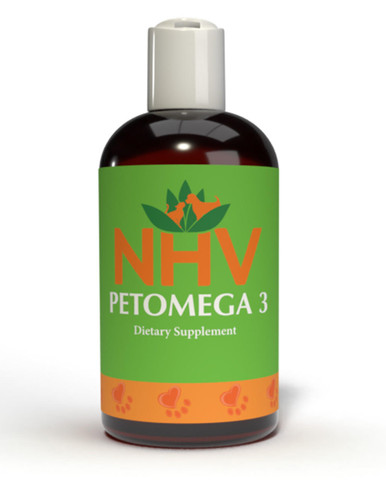
An Omega 3 supplement for cats to support their joints, heart, eyes, immune system, and overall organ function.

Our cat omega 3 supplement is naturally made from the oils of sardines, anchovies, and North Atlantic cod. It’s an excellent source of EPA (Eicosapentaenoic Acid 600mg) and DHA (Docosahexaenoic acid 460mg) essential omega 3 fatty acids. It’s molecularly distilled and cold-pressed to improve the bioavailability
Support your cat with human-grade quality omega 3 fish oil supplements. Many processed pet foods are deficient in this important nutrient. And according to the University of Maryland Medical Center, "It is very important to maintain a balance between omega-3 and omega-6 fatty acids in the diet. A proper balance helps maintain and even improve health."
It’s important for cats to get essential fatty acids through their diet. This omega 3 supplement for cats will help keep them healthy, and even finicky cats actually like to take it.
Benefits of Cat omega 3 supplements:
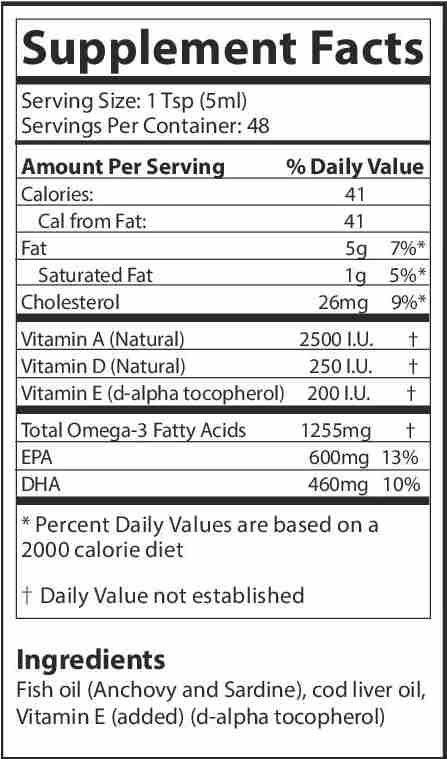
Suggested Dosage: To be taken once per day. Add to food based on weight chart.
Therapeutic Dosage: Double the quantity for maximum period of 4 weeks or follow veterinarian advise.
Pet’s Weight Dosage
0-15 lb = ¼ tsp
15-30 lb = ½ tsp
30-60 lb = 1 tsp
60-90 lb = 1 ½ tsp
How to Administer: Shake well before use. The easiest method is to add the dosage to your pets food. Some pets can be finicky, if this occurs consider hiding the appropriate amount in food most pet’s love such as fish, chicken, yogurt, or a favorite treat. If your pet only eats dry food then soak kibbles at feeding time.
For Best Results
Dietary supplements are beneficial to the health and well-being of your pet and are safe for long-term use. Every pet responds to natural supplements differently, therefore it is important to be consistent and administer the product daily. Supplements generally take two to four weeks to take effect, however this will vary from one animal to the next.
Product Storage
All NHV Natural Pet Products contain no artificial additives, preservatives or coloring. Shelf life after opening is 6 months and must be refrigerated after opening.
Cautions and Contraindications
Avoid During Pregnancy.
Our cat omega 3 supplement is naturally made from the oils of sardines, anchovies, and North Atlantic cod. It’s an excellent source of EPA (Eicosapentaenoic Acid 600mg) and DHA (Docosahexaenoic acid 460mg) essential omega 3 fatty acids. It’s molecularly distilled and cold-pressed to improve the bioavailability
Support your cat with human-grade quality omega 3 fish oil supplements. Many processed pet foods are deficient in this important nutrient. And according to the University of Maryland Medical Center, "It is very important to maintain a balance between omega-3 and omega-6 fatty acids in the diet. A proper balance helps maintain and even improve health."
It’s important for cats to get essential fatty acids through their diet. This omega 3 supplement for cats will help keep them healthy, and even finicky cats actually like to take it.
Benefits of Cat omega 3 supplements:

Suggested Dosage: To be taken once per day. Add to food based on weight chart.
Therapeutic Dosage: Double the quantity for maximum period of 4 weeks or follow veterinarian advise.
Pet’s Weight Dosage
0-15 lb = ¼ tsp
15-30 lb = ½ tsp
30-60 lb = 1 tsp
60-90 lb = 1 ½ tsp
How to Administer: Shake well before use. The easiest method is to add the dosage to your pets food. Some pets can be finicky, if this occurs consider hiding the appropriate amount in food most pet’s love such as fish, chicken, yogurt, or a favorite treat. If your pet only eats dry food then soak kibbles at feeding time.
For Best Results
Dietary supplements are beneficial to the health and well-being of your pet and are safe for long-term use. Every pet responds to natural supplements differently, therefore it is important to be consistent and administer the product daily. Supplements generally take two to four weeks to take effect, however this will vary from one animal to the next.
Product Storage
All NHV Natural Pet Products contain no artificial additives, preservatives or coloring. Shelf life after opening is 6 months and must be refrigerated after opening.
Cautions and Contraindications
Avoid During Pregnancy.
multivitamin support
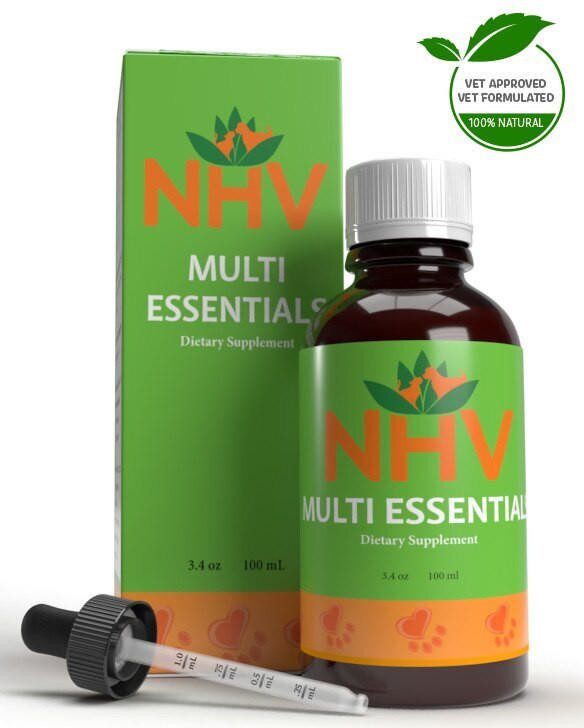
Herbal Digestive Aid, Energy Booster, and Multivitamin for Cats
buy 2 and save $3
3 month supply for a small to medium size pet
These multivitamins for cats will ensure your kitty (of any age) is getting an extra dose of minerals and vitamins for extra energy, vitality, and health.

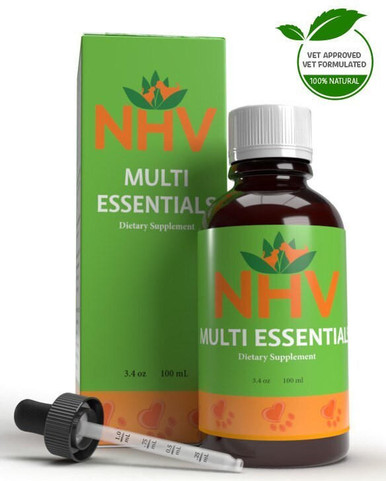
These multivitamins for cats will ensure your kitty (of any age) is getting an extra dose of minerals and vitamins for extra energy, vitality, and health.

The health benefits of multivitamins aren’t just for humans. Cats have many of the same nutrient needs as we do, and some need even more than others depending on their age and health.
A multivitamin supplies the vital nutrients your kitty needs to be healthy and to fight off potential health problems. Dr. Cook, DVM, CVA in her blog states that vitamins “help to regulate the body processes, protect the body from environmental toxins, and break down nutrients such as carbohydrates, proteins, and fats so the body can utilize them”.
The best way to give your cat vitamins and minerals are from whole food sources and not just isolated synthetic vitamins. NHV Multi Essentials contains a powerful blend of alfalfa, oat, dandelion, kelp, parsley, marshmallow, chickweed, stinging nettle, Asian ginseng, yucca and Oregon grape.
Health Benefits of NHV’s Multi-Essentials for Cats
With NHV’s multi vitamins for cats, you get a proprietary blend of all-natural ingredients that are organically grown and contain no artificial additives, preservatives, or coloring. Some of the health benefits include:
Multivitamins for cats will ensure your kitty is getting the proper nutrients that could be lacking due to daily stressors, a poor diet, and environmental toxins.
Signs of Vitamin Deficiency in Your Cat
Kitties Who’ve Benefited from NHV Multi Essentials
NHV multi vitamin for cats has helped thousands of pets around the world. Here are just a few of their stories:
DEALING WITH DIGESTIVE ISSUES: MICI THE CAT LOVES HIS VITAMINS NHV MULTI ESSENTIALS
HERBAL MULTIVITAMINS AND TURMERIC HELP CATS, OATMEAL AND MELISSA LIVE HAPPIER
CAN CATS WITH FELV LIVE A HEALTHY AND NORMAL LIFE?
If you have questions regarding holistic support including vitamin supplements for cats, ask an NHV expert because, at NHV, we want your cat to feel clawtastic naturally!
Select your pet's weight to determine the correct dose.
To be taken twice daily. Determine your pet’s weight and then use the easy chart below to determine the correct dose. This is the minimum dosage.
Pet's Weight Dosage
0 - 15 lb = 0.5 ml
16 - 30 lb = 1.0 ml
31 - 45 lb = 1.5 ml
46 - 60 lb = 2.0 ml
61 - 75 lb = 2.5 ml
Over 75 lb = 3.0 ml
How to Administer
Shake well before use. The easiest method is to use the dropper provide and places the drops into your pet’s food or favorite treat. You can also use the dropper and squirt directly into the pet’s mouth.
Some pets can be finicky, if this occurs consider hiding the drops in foods most pet’s love such as fish, chicken or yogurt or a favorite treat. If your pet only eats dry food then soak a few kibbles at feeding time.
For Best Results
Herbal dietary supplements are beneficial to the health and wellbeing of your pet and are safe for long-term use. Every pet responds to natural herbal supplements differently, therefore it is important to be consistent and administer the product daily. Supplements generally take two to four weeks to take effect, however this will vary from one animal to the next.
Product Storage
All NHV Natural Pet Products are pure herbal extracts and contain no artificial additives, preservatives or coloring. Shelf life after opening is 6 months and must be refrigerated after opening.
Cautions and Contraindications
Do not use Multi Essentials in pregnant or nursing animals. Speak to your vet before using our products. A second visit is recommended if your pet’s condition does not improve, or deteriorates after continued use of the supplements.
All information provided by NHV Natural Pet Products is for educational purposes only.
The health benefits of multivitamins aren’t just for humans. Cats have many of the same nutrient needs as we do, and some need even more than others depending on their age and health.
A multivitamin supplies the vital nutrients your kitty needs to be healthy and to fight off potential health problems. Dr. Cook, DVM, CVA in her blog states that vitamins “help to regulate the body processes, protect the body from environmental toxins, and break down nutrients such as carbohydrates, proteins, and fats so the body can utilize them”.
The best way to give your cat vitamins and minerals are from whole food sources and not just isolated synthetic vitamins. NHV Multi Essentials contains a powerful blend of alfalfa, oat, dandelion, kelp, parsley, marshmallow, chickweed, stinging nettle, Asian ginseng, yucca and Oregon grape.
Health Benefits of NHV’s Multi-Essentials for Cats
With NHV’s multi vitamins for cats, you get a proprietary blend of all-natural ingredients that are organically grown and contain no artificial additives, preservatives, or coloring. Some of the health benefits include:
Multivitamins for cats will ensure your kitty is getting the proper nutrients that could be lacking due to daily stressors, a poor diet, and environmental toxins.
Signs of Vitamin Deficiency in Your Cat
Kitties Who’ve Benefited from NHV Multi Essentials
NHV multi vitamin for cats has helped thousands of pets around the world. Here are just a few of their stories:
DEALING WITH DIGESTIVE ISSUES: MICI THE CAT LOVES HIS VITAMINS NHV MULTI ESSENTIALS
HERBAL MULTIVITAMINS AND TURMERIC HELP CATS, OATMEAL AND MELISSA LIVE HAPPIER
CAN CATS WITH FELV LIVE A HEALTHY AND NORMAL LIFE?
If you have questions regarding holistic support including vitamin supplements for cats, ask an NHV expert because, at NHV, we want your cat to feel clawtastic naturally!
Select your pet's weight to determine the correct dose.
To be taken twice daily. Determine your pet’s weight and then use the easy chart below to determine the correct dose. This is the minimum dosage.
Pet's Weight Dosage
0 - 15 lb = 0.5 ml
16 - 30 lb = 1.0 ml
31 - 45 lb = 1.5 ml
46 - 60 lb = 2.0 ml
61 - 75 lb = 2.5 ml
Over 75 lb = 3.0 ml
How to Administer
Shake well before use. The easiest method is to use the dropper provide and places the drops into your pet’s food or favorite treat. You can also use the dropper and squirt directly into the pet’s mouth.
Some pets can be finicky, if this occurs consider hiding the drops in foods most pet’s love such as fish, chicken or yogurt or a favorite treat. If your pet only eats dry food then soak a few kibbles at feeding time.
For Best Results
Herbal dietary supplements are beneficial to the health and wellbeing of your pet and are safe for long-term use. Every pet responds to natural herbal supplements differently, therefore it is important to be consistent and administer the product daily. Supplements generally take two to four weeks to take effect, however this will vary from one animal to the next.
Product Storage
All NHV Natural Pet Products are pure herbal extracts and contain no artificial additives, preservatives or coloring. Shelf life after opening is 6 months and must be refrigerated after opening.
Cautions and Contraindications
Do not use Multi Essentials in pregnant or nursing animals. Speak to your vet before using our products. A second visit is recommended if your pet’s condition does not improve, or deteriorates after continued use of the supplements.
All information provided by NHV Natural Pet Products is for educational purposes only.
Cat Eye Health
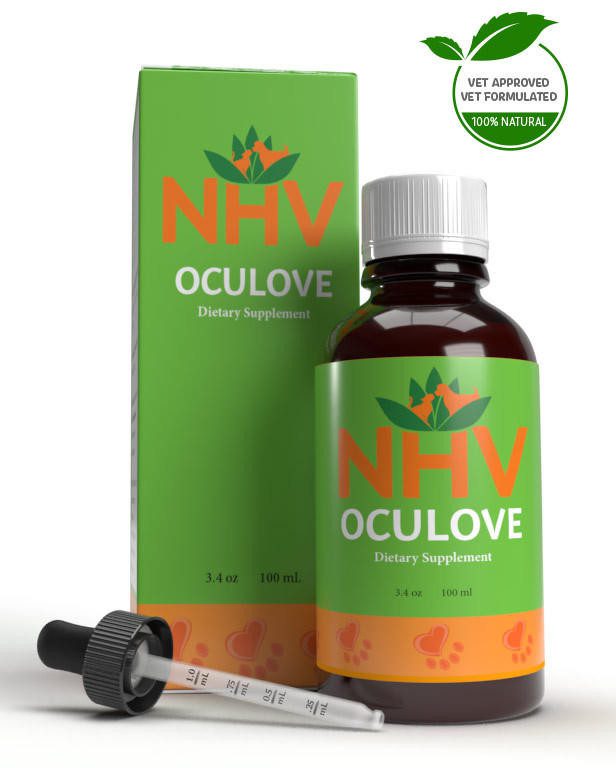
Natural Cat Eye Health Supplement
buy 2 and save $3
3 month supply for a small to medium size pet.
Have you ever watched your kitty’s hypnotic eyes as they dart around the room stalking their favorite toy? Their eyes are definitely one of their most defining feline features! That's why, as a pet parent, it can be very worrisome to see your furry friend’s eyes change from crystal-clear to cloudy or watery. NHV OcuLove is an internal cat eye health supplement that can help support common feline eye problems like corneal damage, cataracts, glaucoma or even infections like pink eye.

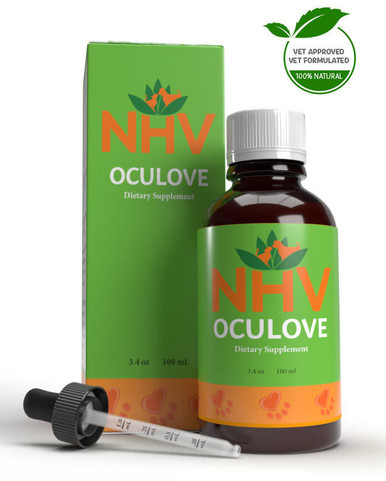
Have you ever watched your kitty’s hypnotic eyes as they dart around the room stalking their favorite toy? Their eyes are definitely one of their most defining feline features! That's why, as a pet parent, it can be very worrisome to see your furry friend’s eyes change from crystal-clear to cloudy or watery. NHV OcuLove is an internal cat eye health supplement that can help support common feline eye problems like corneal damage, cataracts, glaucoma or even infections like pink eye.

Support for Eye Health in Cats (kittens and adults)
Who doesn’t love looking into their cat’s eyes? Whether they are sapphire blue, bright green or maybe even odd-eyed (two different colored eyes). But it can be very worrying to see redness, discharge or irritated blinking. What's going on? Your kitty could be suffering from common feline eye problems like blepharitis (common in Persians and Himalayans) or keratitis (inflamed cornea). OcuLove, a natural cat eye health supplement contains all-natural herbal ingredients known to improve degenerative eye disease, eye infections and support overall eye health. Formulated with herbal extracts like bilberry, eyebright and ginkgo, which have been used for over millennia to improve circulation and oxygenation in the eyes. OcuLove is also beneficial for conditions like pink eye (conjunctivitis), corneal damage, eye inflammation (uveitis) and glaucoma (optical nerve damage).
How NHV OcuLove Cat Eye Health Supplement Supports Eye Health in Kittens and Adult Cats
Like humans, your kitty may suffer from common feline eye problems during their lifetime. An underlying infection often causes conditions like glaucoma or cataracts so ingredients like oregon grape, turmeric and wheatgrass contain anti-inflammatory properties helpful for encouraging healthy eye function. Other ingredients like eyebright, bilberry and gingko help to soothe inflammation (blepharitis, keratitis) and may enhance blood circulation around the eyes. Gingko biloba is known for improving oxygenation in the blood and improving eye conditions like corneal tearing, corneal inflammation, glaucoma, cataracts, dry eyes, conjunctivitis (pink eye) and eye issues in general.
Help your Cat Live A Long And Happy Life, Naturally!
We are always here to support you and your pet! Made with full-spectrum plant extracts which are bioavailable for your furry friend and 100% natural, NHV pet experts are here to answer any eye health-related questions. If you notice any cloudiness, redness, itchiness or discharge from your kitty’s eyes, get in touch with your vet immediately.
Made with the finest, organically grown, or ethically harvested herbs. Made specifically for pets, vet-formulated and vet approved.
Bilberry — Contains anthocyanins which may help improve circulation and blood flow around the eyes. Studies have shown that bilberry is helpful with glaucoma, corneal damage, conjunctivitis (pink eye), and overall issues that affect the eye.
Eyebright — Contains anti-inflammatory properties. It has been used for centuries to help with itchy eyes and inflammation of the eyelid and blood vessels.
Gingko — Has a long history of being used to enhance oxygenation around the eyes and in the body, and is beneficial for conditions like glaucoma.
Wheatgrass — Contains twice as much vitamin A compared to carrots so it's beneficial for eye health. It may soothe inflammation and fight infections of the eye.
Turmeric — Contains antioxidant, anti-inflammatory properties that help fight oxidative stress and slow down overall eye deterioration.
Oregon grape — Is beneficial for fighting eye infections and may help improve overall eye health and support the immune system.
Select your pet's weight to determine the correct dose.
To be taken twice daily. Determine your pet’s weight and then use the easy chart below to determine the correct dose. This is the minimum dosage.
Pet's Weight Dosage
0 - 15 lb = 0.5 ml
16 - 30 lb = 1.0 ml
31 - 45 lb = 1.5 ml
46 - 60 lb = 2.0 ml
61 - 75 lb = 2.5 ml
Over 75 lb = 3.0 ml
Some pets may require a larger dosage due to their metabolism. You can safely double the recommended dosage.
How to Administer
Shake well before use. Use the dropper provided to squirt the dosage directly into your pet’s mouth along the gums and teeth. Some pets may be finicky and resist your attempts to administer drops directly into their mouth. If this occurs, try placing the drops in your pet’s food or favorite treat. You may want to consider hiding the drops in foods most pet’s love such as fish, chicken, or yogurt. When serving dry food, use the dropper to soak a few kibbles at feeding time.
For Best Results
Herbal dietary supplements are beneficial to the health and wellbeing of your pet and are safe for long-term use. Every pet responds to natural herbal supplements differently, therefore it is important to be consistent and administer the product daily. Supplements generally take two to four weeks to take effect, however this will vary from one animal to the next.
Product Storage
All NHV Natural Pet Products are pure herbal extracts and contain no artificial additives, preservatives or coloring. Shelf life after opening is 6 months and must be refrigerated after opening.
Cautions and Contraindications
Do not use Mouth Drops in pregnant or nursing animals. Speak to your vet before using our products. A second visit is recommended if your pet’s condition does not improve, or deteriorates after continued use of the supplements.
All information provided by NHV Natural Pet Products is for educational purposes only.
Support for Eye Health in Cats (kittens and adults)
Who doesn’t love looking into their cat’s eyes? Whether they are sapphire blue, bright green or maybe even odd-eyed (two different colored eyes). But it can be very worrying to see redness, discharge or irritated blinking. What's going on? Your kitty could be suffering from common feline eye problems like blepharitis (common in Persians and Himalayans) or keratitis (inflamed cornea). OcuLove, a natural cat eye health supplement contains all-natural herbal ingredients known to improve degenerative eye disease, eye infections and support overall eye health. Formulated with herbal extracts like bilberry, eyebright and ginkgo, which have been used for over millennia to improve circulation and oxygenation in the eyes. OcuLove is also beneficial for conditions like pink eye (conjunctivitis), corneal damage, eye inflammation (uveitis) and glaucoma (optical nerve damage).
How NHV OcuLove Cat Eye Health Supplement Supports Eye Health in Kittens and Adult Cats
Like humans, your kitty may suffer from common feline eye problems during their lifetime. An underlying infection often causes conditions like glaucoma or cataracts so ingredients like oregon grape, turmeric and wheatgrass contain anti-inflammatory properties helpful for encouraging healthy eye function. Other ingredients like eyebright, bilberry and gingko help to soothe inflammation (blepharitis, keratitis) and may enhance blood circulation around the eyes. Gingko biloba is known for improving oxygenation in the blood and improving eye conditions like corneal tearing, corneal inflammation, glaucoma, cataracts, dry eyes, conjunctivitis (pink eye) and eye issues in general.
Help your Cat Live A Long And Happy Life, Naturally!
We are always here to support you and your pet! Made with full-spectrum plant extracts which are bioavailable for your furry friend and 100% natural, NHV pet experts are here to answer any eye health-related questions. If you notice any cloudiness, redness, itchiness or discharge from your kitty’s eyes, get in touch with your vet immediately.
Made with the finest, organically grown, or ethically harvested herbs. Made specifically for pets, vet-formulated and vet approved.
Bilberry — Contains anthocyanins which may help improve circulation and blood flow around the eyes. Studies have shown that bilberry is helpful with glaucoma, corneal damage, conjunctivitis (pink eye), and overall issues that affect the eye.
Eyebright — Contains anti-inflammatory properties. It has been used for centuries to help with itchy eyes and inflammation of the eyelid and blood vessels.
Gingko — Has a long history of being used to enhance oxygenation around the eyes and in the body, and is beneficial for conditions like glaucoma.
Wheatgrass — Contains twice as much vitamin A compared to carrots so it's beneficial for eye health. It may soothe inflammation and fight infections of the eye.
Turmeric — Contains antioxidant, anti-inflammatory properties that help fight oxidative stress and slow down overall eye deterioration.
Oregon grape — Is beneficial for fighting eye infections and may help improve overall eye health and support the immune system.
Select your pet's weight to determine the correct dose.
To be taken twice daily. Determine your pet’s weight and then use the easy chart below to determine the correct dose. This is the minimum dosage.
Pet's Weight Dosage
0 - 15 lb = 0.5 ml
16 - 30 lb = 1.0 ml
31 - 45 lb = 1.5 ml
46 - 60 lb = 2.0 ml
61 - 75 lb = 2.5 ml
Over 75 lb = 3.0 ml
Some pets may require a larger dosage due to their metabolism. You can safely double the recommended dosage.
How to Administer
Shake well before use. Use the dropper provided to squirt the dosage directly into your pet’s mouth along the gums and teeth. Some pets may be finicky and resist your attempts to administer drops directly into their mouth. If this occurs, try placing the drops in your pet’s food or favorite treat. You may want to consider hiding the drops in foods most pet’s love such as fish, chicken, or yogurt. When serving dry food, use the dropper to soak a few kibbles at feeding time.
For Best Results
Herbal dietary supplements are beneficial to the health and wellbeing of your pet and are safe for long-term use. Every pet responds to natural herbal supplements differently, therefore it is important to be consistent and administer the product daily. Supplements generally take two to four weeks to take effect, however this will vary from one animal to the next.
Product Storage
All NHV Natural Pet Products are pure herbal extracts and contain no artificial additives, preservatives or coloring. Shelf life after opening is 6 months and must be refrigerated after opening.
Cautions and Contraindications
Do not use Mouth Drops in pregnant or nursing animals. Speak to your vet before using our products. A second visit is recommended if your pet’s condition does not improve, or deteriorates after continued use of the supplements.
All information provided by NHV Natural Pet Products is for educational purposes only.
Published: June 20, 2023